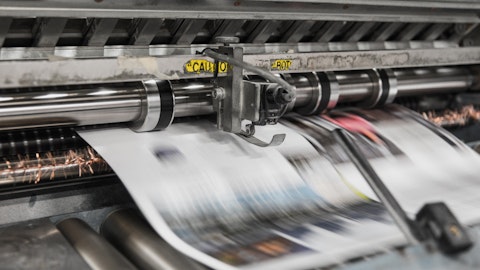Cimpress plc (NASDAQ:CMPR) Q1 2024 Earnings Call Transcript October 26, 2023
Operator: Welcome to the Cimpress Q1 Fiscal Year 2024 Earnings Call. I will introduce Meredith Burns, Vice President of Investor Relations and Sustainability.
Meredith Burns: Thank you, Tanya, and thank you, everyone, for joining us. With us today are Robert Keane, our Founder, Chairman and Chief Executive Officer; and Sean Quinn, EVP and Chief Financial Officer. I hope you’ve all had a chance to read our earnings document published yesterday. We appreciate the time you have dedicated to understand our results, commentary, and outlook. This live Q&A session will last 45 minutes to an hour, and we’ll answer both pre-submitted and live questions. You can submit questions live via the questions and answers box at the bottom left of your screen. Before we start, I’ll note that in this session, we will make statements about the future. Our actual results may differ materially from these statements due to risk factors that are outlined in detail in our SEC filings and in the documents we published yesterday on our website.

An industrial printing machine churning out specialized orders for a major client.
We also have published non-GAAP reconciliations for our financial results and outlook on our IR website. We invite you to read them. And now I will turn things over to Sean for some brief remarks before we take questions. Sean?
Sean Quinn: Thanks a lot Meredith, and thanks to everyone who has joined us today. Before we take questions, I’ll just highlight a few key points from the financial results and also the updated outlook that we published yesterday. First of all, we delivered solid results in the first quarter. Consolidated revenue grew 8% on a reported basis and 4% on an organic constant currency basis. Growth did vary by segment and it was also reduced by approximately 200 basis points from year-over-year revenue timing changes. Consolidated profits were very strong. Adjusted EBITDA grew $43 million year-over-year in Q1 to $89 million. Adjusted EBITDA margin was up from 6.5% last year to 11.7% this year. This benefited from gross margin expansion from leverage and advertising spend and reduced operating expenses.
Adjusted EBITDA expansion over the last three quarters has been very significant. Our trailing 12-month adjusted EBITDA at the end of September was $383 million, and that compares to $228 million at the end of December, a 68% increase in just nine months and still with a significant benefit from our prior cost reductions yet to impact those reported results. Adjusted free cash flow for the quarter increased significantly year-over-year by just over $63 million with a higher adjusted EBITDA and also a significantly more favorable in net working capital compared to the year ago period, which was helped by returns to more normalized inventory patterns. I won’t go through all of the segments here today. But given the significance of the profitability expansion in Vista, let me just share some highlights there.
See also 12 Best Undervalued Energy Stocks To Buy According to Analysts and 11 Best Gun Stocks To Buy in 2023.
Q&A Session
Follow Cimpress Plc (NASDAQ:CMPR)
Follow Cimpress Plc (NASDAQ:CMPR)
Receive real-time insider trading and news alerts
This is revenue grew 6% on an organic constant currency basis. Overall, revenue growth was driven by approximately even contribution from growth in orders and then higher average order values. The higher average order value is driven by both product mix and pricing. Revenue grew across geographic markets and across product lines with the fastest growth continuing to come from our promotional products apparel and gifts category, signage and packaging and labels. There’s a lot of investor focus on Europe these days, and I’ll note that for Vista, growth in Europe was quite strong in Q1. Vista segment EBITDA grew $44 million versus last year, which similar to last quarter was driven by a balanced mix of revenue growth, gross margin expansion, lower advertising spend as a percentage of revenue, which decreased and materially lower operating costs as a result of the cost reductions that we announced back in March.
Importantly, in Vista, We’re also seeing continued improvements in per customer value, which is a trend that’s been in place for the past several years. But we’re now also doing that while growing the customer base year-over-year, which grew by more than 100,000 customers in the first quarter. That was primarily driven by new customer growth and those new customers generated record levels of in-quarter variable gross profit per customer when compared to past Q1 new customer cohorts. There are many small improvements that contribute to this and there remains a lot of opportunity for more of these improvements, which can have a meaningful impact on our overall customer experience, conversion rate, and financial results, and that’s where our focus is.
From a balance sheet perspective, we ended the quarter with cash and marketable securities of $148 million, even after we purchased $21 million notional value of our 7% senior notes, for just under $20 million. Net leverage decreased sequentially to just over 3.5 times trailing 12-month EBITDA as defined by our credit agreement. As we talked about on recent calls, from a balance sheet perspective, we’ve been prioritizing reduction in net leverage and that’s happening at a good pace. Moving to our outlook. Given our strong Q1 profitability and cash flow performance, we’re raising our FY 2024 adjusted EBITDA guidance to at least $425 million, and we continue to expect that to convert to free cash flow at approximately 40%. Our organic constant currency revenue guidance of at least 6% remains unchanged.
We recognize there’s some macroeconomic uncertainty in most parts of the world, and we’ll of course be monitoring that as it relates to future revenue commentary. Our expectation is still to end the year with net leverage that is below 3.25 times. So, that also remains unchanged. And with that, Meredith, why don’t we open it up for questions?
A – Meredith Burns: You bet. Thanks Sean. [Operator Instructions] So we’ll get to as many as we can and make sure we get to a variety of top it around people’s minds. So the first question, is I’m going to throw it to Sean. So on a reported basis, Vista Europe grew at 17% year-over-year, which we assume translates to 8% to 9% once FX effects are removed. Are we thinking about this the right way? And if so, what is driving faster organic constant currency growth in Europe versus North America?
Sean Quinn: Yes. Thanks. Just so everyone knows on the call, we publish financial and operating metrics each quarter, which we post on our Investor Relations site and that’s where the data is that would have prompted this question. The constant currency revenue growth in Vista Europe, as actually just above 10%. So it was a little higher than the math that whomever asked the question was doing. And that was indeed higher than North America, but both regions perform well. I would say that even beyond just the revenue growth in Europe being just above 10%, gross profit grew at a higher rate there and contribution profit grew at an even higher rate. And so, again, overall, a very strong quarter for Vista, but also in particular in Europe.
At a category level, there’s two areas to call out in terms of where, performance was, or growth was higher in Europe and that would be in packaging and labels and also in marketing materials. Those two categories happen to be the ones that benefit the most from leveraging new product introduction, from fulfillment from other Cimpress businesses in Europe, which there’s not that same opportunity in North America. The combination of the technology migration that we did last year, which just to keep in mind, there were the latest markets to be migrated were a few of our large European markets. So, kind of the benefit of that is a little bit delayed. And there’s also organizational changes that we put in place back in March. And I think the combination of technology migration and those organizational changes has allowed the team, to have more focus in Europe and also to move more quickly to have customer impact in those markets versus a year ago.
There were pretty meaningful improvements in customer credit rates that was notable in Europe, due to a lot of the work of our customer care teams that’s beneficial to revenue. That was also a good trend in North America, just a little bit better in Europe. And then I would say we’ve also been able to take the learnings from other markets, both from an advertising spend perspective, but also in areas like pricing, or how we’re thinking about promotionality, and bring those to, some of our European markets in ways that we haven’t before and that is that is definitely having an impact. So, in general, I would say it’s primarily, micro factors rather than macro factors that delivered the differential performance.
Meredith Burns: Great. Thank you, Sean. All right. So, we’re going to stick with revenue here and we’ve had several questions trying to really sort of pick apart the differential growth rates by segments, and some of the, the timing impacts there. So, I’ll ask one question and touch on the other, other questions that came in on this and you can cover all of them at once in detail. So, in a lot of ways, it was a strong quarter, but revenue growth rates declined sequentially in all segments and are lower than your annual growth expectation. What were the key contributing factors to that? And given your continued confidence in the annual growth rate, was the decline this quarter expected? And then the other questions around this are really getting at, the growth rates in our Upload and Print businesses, and why there was a difference between those two groups?
Sean Quinn: Yes. Okay. I’ll do my best here. Yes, first of all, agree with the overall sentiment we believe that it was a strong quarter. Profitability and cash flow were quite strong. But there was some variability in the revenue growth. So, I’ll dive into that. There’s I had mentioned in the opening remarks, there’s about 200 basis points of timing impacts too that that are a drag on consolidated growth rate. Over half of that, we’ll benefit revenue in the remainder of the year. As backlog normalizes, there’s really nothing to that other than timing. So, just know that that had some impact. And then I would also just keep in mind that the expectations that we set coming into the year was that we were going to have lower growth, and particularly in our Upload and Print businesses as we lap pricing changes from last year and so on.
In terms of how we performed versus our expectations, generally speaking, let’s say Vista was right on plan, other than the timing impact that I outlined, we feel good about the quarter there. The fact that per customer value continue to improve while customer counts also grew, as I noted, I think is a is a good signal as well. So, System was right on track and solid quarter. And Upload and Print, those, both of those segments within Upload and Print, each grew over 20% in Q1 last year in constant currency. So, we’re lapping that, we’re lapping pricing, increases. So, it’s still a tough comp. But relative to expectations, there, I’d say it’s a little bit more of a nuanced story and you kind of have to get down to the country category channel level to better understand that.



